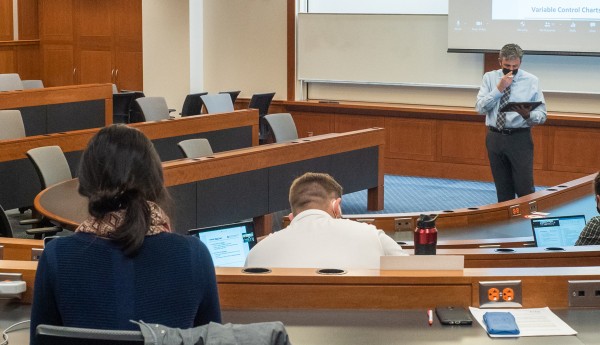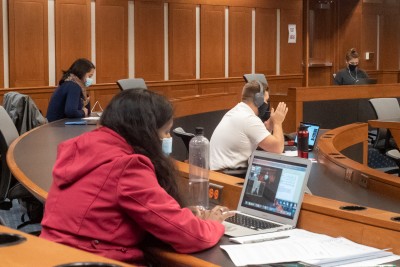Three Steps to Building Community in Online and Hybrid Courses

There’s a buzz of energy in a classroom when students enter. They’re making jokes, comparing notes on the homework you assigned last week, and organizing study groups. How do you create that same feeling of camaraderie when your class is separated by cameras and computer screens?
Fortunately, there’s a lot you can do to plant those seeds and nurture your students throughout the semester, allowing community to blossom in your online classes.
1. Establish an open culture
As the instructor, you set the tone for your class. Consider creating a short video introducing yourself to help your students get to know you. If you have synchronous sessions, you can use icebreakers to encourage the class to open up to each other.
Assignments, too, can help set the tone for authentic interactions in your class. Jennifer Olejownik, a clinical instructor in the School of Health and Rehabilitation Sciences, said that in her one of her integrative medicine courses, students read a book about mindfulness throughout the semester and write a short reflection each week about how the ideas relate to their lives.
“They’re one-point assignments, but I always make a point to read those because a lot of times, students convey personal information in there,” Olejownik said. “It’s a way that I get to know my students in a much deeper way. It’s not uncommon for them to write about struggles with their family … or struggles with an eating disorder or some type of health issue. All those things come out and it gives me a really unique way to watch them as they’re progressing through this content, but it also shows me who they are as a person.”
Most importantly, be yourself. Darcy Hartman, a senior lecturer for the Department of Economics in the College of Arts and Sciences, says she’s found this to be effective in creating an open culture even in large classes.
“Don’t be afraid to let your vulnerability show with your students,” said Hartman, who typically teaches lectures of 500 to 600 students and found herself unexpectedly leading an online “mega-lecture” of 1,000 this fall. “You don’t have to have these perfectly recorded lectures. (Students are) going to engage and relate the more real you are.”
2. Create spaces for community to grow

Whether your course is hybrid or fully online, synchronous or asynchronous, you can offer ongoing opportunities for authentic connection between your students. These can be baked into your course as part of graded assignments and activities or they can be optional activities.
On a recent Friday night, five of the seven graduate students in Emily Patterson’s course gathered on Zoom to play the game Two Truths and a Lie. The optional game night immediately preceded the students’ first group project for Quality Management and Performance Improvement in Healthcare.
“It worked really well,” said Patterson, an associate professor in the School of Health and Rehabilitation Sciences, College of Medicine. “Each person said three things about themselves—two things that were true and one that was a lie—and then we had to pick which one was the lie. They got points cumulatively, and I sent a DoorDash appetizer to the person who won. They were so into it.”
Students in Jurriaan de Jong’s graduate-level Operations Management class get to know each other through breakout room discussions in CarmenZoom, where they talk about the case that was assigned that week. At the end of the evening, each breakout room submits a page of notes to a group assignment de Jong has set up in CarmenCanvas.
“Back when we were in person, I would always have one team present the case,” said de Jong, an assistant professor in Fisher College of Business.
“These short, small meetings in breakout rooms are actually a lot more effective. You get to learn from two or three or your peers, and then we bring people back to the big room to discuss (the case) as a larger group.”
3. Offer channels for student feedback
Once you’ve laid the foundation for authentic connections to take place and made room for them to grow, give your students a chance to tell you what is and isn’t working for them about your class. These could be informal exchanges, such as question and answer sessions at the start or end of a synchronous class, or formal evaluations, like periodic surveys.
Hartman’s “mega-lecture” is set up as a CarmenZoom webinar, which she co-hosts with her graduate teaching assistant Vanessa Ordoñez, and it ends up feeling a bit like a radio or talk show. “We show up about 10 minutes before class starts, and she and I talk back and forth while the chat room starts to fill up,” Hartman said. Students are encouraged to use the Zoom chat or Q&A to ask questions about the material that’s currently being taught. Hartman also offers office hours, has a public Twitter presence and encourages student feedback via email.
If you administer a survey, the Office of Academic Affairs suggests just a handful of questions like “What is helping you learn in this class?” and “What, if anything, is still unclear?” via Qualtrics or an ungraded quiz in CarmenCanvas. You can even ask students to rate the sense of community—how connected they feel to each other—within the course.
Look to data and feedback to see how you’re doing at building community in your classes instead of relying on your gut feeling about how the semester is going. You just might be surprised by the results.
Want more strategies for online teaching? Explore teaching topics in the Teaching and Learning Resource Center.
